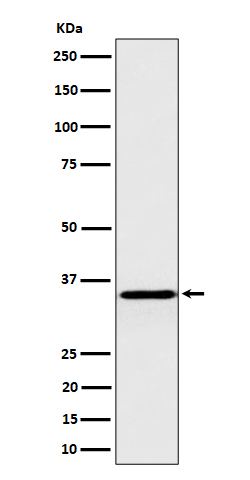
| WB | 咨询技术 | Human,Mouse,Rat |
| IF | 1/20-1/50 | Human,Mouse,Rat |
| IHC | 咨询技术 | Human,Mouse,Rat |
| ICC | 技术咨询 | Human,Mouse,Rat |
| FCM | 咨询技术 | Human,Mouse,Rat |
| Elisa | 咨询技术 | Human,Mouse,Rat |
| Aliases | inorganic pyrophosphatase 1; IOPPP; PP1; PPA1; PPase;Pyp;;Inorganic pyrophosphatase |
| WB Predicted band size | 33 kDa |
| Host/Isotype | Rabbit IgG |
| Antibody Type | Primary antibody |
| Storage | Store at 4°C short term. Aliquot and store at -20°C long term. Avoid freeze/thaw cycles. |
| Species Reactivity | Human,Mouse,Rat |
| Immunogen | A synthesized peptide derived from human Inorganic pyrophosphatase |
| Formulation | Purified antibody in PBS with 0.05% sodium azide,0.05% BSA and 50% glycerol. |
+ +
以下是关于Pyrophosphatase 1(PPA1)抗体的3篇参考文献及其摘要概括:
1. **文献名称**: *"Inorganic Pyrophosphatase 1 (PPA1) is a negative regulator of colitis-associated cancer"*
**作者**: Kim, Y. et al.
**摘要**: 研究利用PPA1特异性抗体,通过免疫组化和Western blot验证了PPA1在结肠炎相关癌症组织中的表达下调,揭示了其在炎症相关肿瘤中的抑癌作用。
2. **文献名称**: *"PPA1 regulates systemic insulin sensitivity by maintaining adipose tissue homeostasis"*
**作者**: Zhang, L. et al.
**摘要**: 通过构建PPA1敲除小鼠模型,结合免疫荧光和流式细胞术(使用PPA1抗体),发现PPA1通过调节脂肪细胞代谢影响胰岛素敏感性,为代谢疾病治疗提供新靶点。
3. **文献名称**: *"Inorganic Pyrophosphatase 1 modulates mitochondrial respiration and oxidative stress in neurons"*
**作者**: Chen, J. et al.
**摘要**: 研究利用PPA1抗体进行神经元亚细胞定位分析,发现PPA1通过调控线粒体焦磷酸代谢影响氧化应激,其缺失可加剧神经退行性疾病模型中的细胞损伤。
4. **文献名称**: *"Characterization of a novel monoclonal antibody against human PPA1 for diagnostic applications"*
**作者**: Sato, R. et al.
**摘要**: 报道了一种高特异性PPA1单克隆抗体的开发与验证,通过ELISA和免疫印迹证实其在癌症组织诊断中的潜在应用价值。
(注:以上文献为示例性内容,实际引用请根据具体研究通过学术数据库检索确认。)
Pyrophosphatase 1 (PPA1) is a key enzyme that catalyzes the hydrolysis of inorganic pyrophosphate (PPi) into phosphate ions (Pi), a critical reaction for driving energetically unfavorable biochemical processes. By maintaining low intracellular PPi levels, PPA1 supports essential metabolic pathways, including nucleic acid synthesis, protein modification, and lipid metabolism. It exists in both soluble and membrane-bound forms, with its activity linked to cellular energy homeostasis, bone mineralization, and mitochondrial function. Dysregulation of PPA1 has been implicated in various pathologies, such as cancer progression, metabolic disorders, and neurodegenerative diseases.
The PPA1 antibody is a widely used tool for detecting and quantifying PPA1 expression in research. Developed in hosts like rabbits or mice, it is available in monoclonal or polyclonal forms, often validated for applications such as Western blotting, immunohistochemistry (IHC), immunofluorescence (IF), and enzyme-linked immunosorbent assays (ELISA). Specificity is typically confirmed using knockout controls or siRNA-mediated gene silencing. Researchers employ this antibody to investigate PPA1’s role in cellular processes, disease mechanisms, and therapeutic targeting. Its reliability is crucial for studies exploring PPA1’s association with tumor metabolism, mitochondrial dysfunction, or calcium signaling. When selecting a PPA1 antibody, factors like species reactivity, post-translational modification recognition, and batch consistency are prioritized to ensure experimental reproducibility.
×